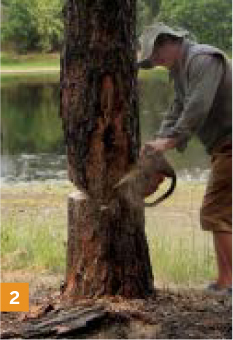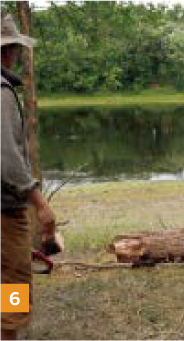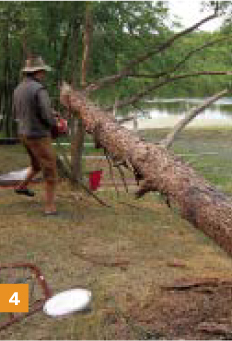HEIRLOOM TECHNOLOGY
THE WIDOWMAKER: CUTTING DOWN A TREE
‘‘Screw your courage to the sticking place ...’’
![]() WARNING! Get really drunk first. Then it won’t hurt so much when you chainsaw your face off and crush your family.
WARNING! Get really drunk first. Then it won’t hurt so much when you chainsaw your face off and crush your family.
Step 0. Find a tree to cut down.
No problem. As soon as you know how to cut down a tree, people will sense it and constantly ask you to cut down trees for them.
Here’s some helpful technical vocabulary:
» Equipment Every piece of equipment used in this process is called a “widowmaker.”
» Tree anatomy The tree, and every part of the tree, is called a “widowmaker.”
» Terrain analysis Everything in the vicinity of the tree is called a “widowmaker.”
Act really confident and relaxed, as shown in Figure O. I’m saying, “You mean this tree over here?”
Step 1. Cut a notch in the felling direction.

Make it a big notch that goes more than halfway through the tree. The “mouth” part of this notch faces the direction you want your tree to fall.
If the tree is mostly upright and its branches are sort of symmetrical, it will want to fall in the direction of the notch mouth. Tie a rope to the top of the tree to help it fall in the direction you want.
Step 2. Cut toward the notch from the other side.

Cut from the other side toward the big notch. It’s just a single cut straight toward the big notch, leaving a thin “living hinge” to make an axis of rotation to control the trunk’s fall. When you get close to the notch, the tree will start to lean away from you. If it doesn’t, or if it leans the wrong way and binds your saw blade, have the Oompa-Loompas pull on the rope tied to the top of the tree.
Step 3. The tree falls.

As the tree starts to lean, make your escape to one side, because the butt of the tree can kick backward. There isn’t any very safe place to be, because huge branches can break and fly anywhere, or the top of the tree could pull something down with it.
ODE TO THE SWEDE SAW
In the lower left of Figure 4, you see a couple of handsaws on the ground. Those are old bow saws, also called “Swede saws” because of where they were invented.
One of our old Minnesota neighbors cut firewood for a living with a big old crosscut (cuts on both strokes) two-handed handsaw in the 1930s. He was just getting by, selling 4 cords of wood a day. Then he bought one of the new Swede saws, started cutting 8 cords a day, and had enough money to get married.
The tubular steel bow puts the blade under high tension so the blade can be very thin without puckering. Because the blade is narrow, it won’t bind in the kerf (groove made by a cutting tool) as much. Bow saws can cut a very narrow kerf, removing less wood, and do it fast with less work than previous saws, which weren’t much different from what the Romans had.
My cousin’s father-in-law was killed by a vine that was pulled by a tree as it fell.
If you didn’t cut all the way to the notch, your “living hinge” may keep the tree from falling to the side.
Step 4. The tree’s hung up. Now what?
I misjudged the height of the tree and the distance to its nearest neighbor. I have no depth perception. That’s why they wouldn’t let me fly jets. It fell in the right direction, but it skinned the next tree over and hung up in it. Now it needs to be sawn through the middle to finish falling down.
There are always problems like this. This one’s called a “widowmaker” because you’ve just compressed the spring of a giant trap, and now you’ve got to walk into it and saw through the trigger.
Step 5. Saw up from the bottom.

Photography by Moana Minton
There’s no safe way to proceed once you’ve got a “leaner” tree hanging like a compressed spring. If you cut down from the top, the tree will sag and bind the blade like a clamp. This is dangerous, because if the blade catches, then the chainsaw kicks back at you and can alter your appearance. Basically, you need a safe way (there isn’t one) to cut the middle of something supported on both ends.
Here’s my cousin Rod’s method: Saw up from the bottom until the tree starts to sag. Then saw down from the top until a good outcome ensues. Cut a notch if the blade starts to bind.
Step 6. Check yourself into the clinic.

I stand in awe at the sight of this forest giant laid low. If things don’t go so well, your loved ones will get to contemplate your own mortality.
Tim Anderson (mit.edu/robot) is the founder of Z Corp. See a hundred more of his projects at instructables.com.


